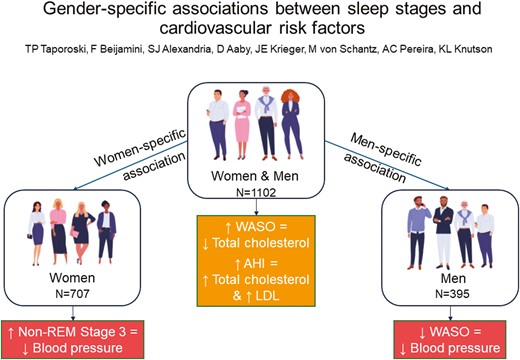-
Views
-
Cite
Cite
Tâmara P Taporoski, Felipe Beijamini, Shaina J Alexandria, David Aaby, Jose E Krieger, Malcolm von Schantz, Alexandre C Pereira, Kristen L Knutson, Gender-specific associations between sleep stages and cardiovascular risk factors, Sleep, Volume 48, Issue 3, March 2025, zsae242, https://doi.org/10.1093/sleep/zsae242
Close - Share Icon Share
Abstract
Sleep characteristics are associated with cardiovascular disease (CVD) risk and both sleep and CVD risk vary by gender. Our objective was to examine associations between polysomnographic sleep characteristics and CVD risk after excluding moderate-severe sleep apnea, and whether gender modifies these associations.
This was a cross-sectional study with at-home polysomnography in adults in Brazil (n = 1102 participants with apnea–hypopnea index (AHI) <15 events/hour). Primary exposures were N3, REM, wake after sleep onset (WASO), arousal index, and AHI, and outcomes were blood pressure (BP) and lipid levels.
Associations between sleep and BP varied by gender. In women, more N3 was associated with lower systolic BP (−0.40 mmHg per 10 minutes, 95% CI: −0.71, −0.09), lower diastolic BP (−0.29 mmHg per 10 minutes, 95% CI: −0.50, −0.07), and lower odds of hypertension (OR 0.94, 95% CI: 0.89, 0.98). In men, more WASO was associated with higher systolic BP (0.41 mmHg per 10 minutes, 95% CI: 0.08, 0.74) and higher odds of hypertension (OR 1.07, 95% CI: 1.01, 1.14). No interactions by gender were observed for lipids. More WASO was associated with lower total cholesterol (−0.71 per 10 minutes, 95% CI: −1.37, −0.05). Higher AHI was associated with higher total cholesterol (+0.97 per event/hour, 95% CI: 0.24, 1.70) and higher LDL (+0.84 per event/hour, 95% CI: 0.04, 1.64).
N3 is more strongly associated with BP in women, which is consistent with other studies demonstrating gender differences in BP control and CVD risk and adds a novel risk factor. Longitudinal and interventional studies are required to determine whether changes in N3 result in BP changes.

- hypertension
- ldl cholesterol lipoproteins
- triglycerides
- cardiovascular diseases
- heart disease risk factors
- obstructive sleep apnea
- blood pressure
- arousal
- adult
- brazil
- polysomnography
- sleep apnea syndromes
- sleep stages
- lipids
- lipids measurement
- gender
- sleep
- diastolic blood pressure
- total cholesterol
- gender differences
- apnea-hypopnea index procedure









Comments